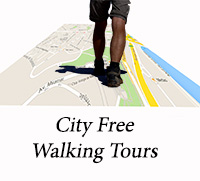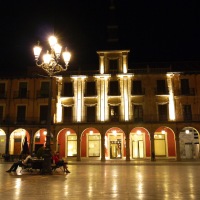At 11am we got to the edge of Vientiane, the capital city of Laos, from where we started hitch-hiking southwards. It had been a long walk, in burning tropical sun and muggy air, when we finally managed to get to the perfect hitch-hiking spot in the suburbs. Hitch-hiking out of capital cities is always a bitch! Jon wasn’t feeling very well and we noticed weird-looking red spots on his back, but since we’d already gone this far, we decided to push on as coming back to the centre just to see a doctor seemed, at the time, to be so much effort.
We got a lift and by the evening we found ourselves in Savannakhet, the second-largest city in Laos. The town was quite pleasant with its sleepy atmosphere and old French colonial architecture, so the next day was just spent walking around and lingering at street eateries. In the evening we noticed that the red spots on Jon’s body had increased in number and now not only did they cover his back, but also his neck, arms and stomach. It didn’t look good at all so we decided to pay a visit to the local hospital the following day.
At the back of our Lonely Planet guidebook, there was a health section in which we found descriptions of all manner of tropical diseases and a comment that Laotian healthcare is probably the worst of all the Southeast Asian countries and should be avoided at all costs. That didn’t discourage us, however, as we thought: ‘what’s the worst that can happen?’ After all, we were in a relatively big city (for Laos that is) and far away from any other form of civilization, so that was our only option.
Getting to the hospital the next day was already a bit of a mission, due to the fact that Laos has mostly dirt roads, which don’t tend to provide good service in rainy season. It had been raining all morning & night, and wading through knee-deep puddles of brown muddy water wasn’t easy. Eventually we decided to take a tuk-tuk, which is a very popular form of transport in Asian countries and consists of a scooter with a passenger cabin attached at the back. It took us a good couple of hours, but eventually we got to our destination.
The hospital was a one storey building that resembled more a prefab than a city hospital. But what was inside is far worthier of a description. Having entered the building, we realized we were the only westerners in sight and got easily spotted by a nurse, who hurriedly approached us and put sanitary masks on our faces. Not out of concern for our health, but rather in fear of us bringing in dangerous western germs. It was during the times of the infamous swine flu pandemic and everywhere in Asia sanitary masks were in fashion more than any other garment.
The nurse disappeared as quickly and wordlessly as she’d emerged from the depths of the hospital, and we were left to ourselves again. There was no reception whatsoever nor any helpful soul in sight so we went on, not discouraged just yet. As we proceeded into the narrow and dingy corridor, we could see some helpful and instructive posters on how to wash your hands in times of swine flu and how to cover your mouth or even better – how to put on a mask (!) – if you find yourself in the vicinity of an ill-looking person.
As we marched on, we got to another corridor, where we could see a group of patients hobbling around or sitting motionlessly against the walls. There were also lines of beds along both walls, in which there were people, not in pyjamas as you’d expect to see in a hospital, but in their casual clothes, covered only with some flimsy blankets. As we were walking past them, we couldn’t avoid strange and mistrustful looks. Some hastily put their masks on, while others decided to immerse themselves into the darkness of the corridor. Not that Laotians are generally mistrustful people, but during these times most Asians seem to be a bit weary of westerners, especially the ill-looking ones.
Having sown general distress and given most patients the creeps, we finally managed to find a person in a medical gown, who directed us to a French-speaking doctor, as this was the only European language which had a chance of being known or understood by the local, due to the country’s colonial past. Jon got examined and the doctor ordered blood tests, which had to be done in another section of the hospital.
Finding the right place again took us a while, given the fact there were no signs, no reception and there wasn’t even anybody to ask for directions, as everyone seemed to be avoiding us like the plague. We got there eventually, and Jon got the blood sample taken. The results were due the following day.
When we returned to the hospital the following morning and managed to get through the dingy maze of suspicious looks again, we met our French-speaking doctor who, having examined Jon and having gone through the blood tests results, gave us his diagnosis. La grippe. Which is French for flu.
‘But doctor, how can this be flu?’ said I in my far from perfect French. ‘He has no temperature, no cough, no headache, no muscle aches and he doesn’t even have s sore throat.’
‘It’s flu,’ repeated the doctor in all his professional firmness.
‘But all he’s got is this rash, nothing else, he doesn’t even feel bad,’ I insisted. ‘Maybe it’s some sort of an allergy’.
‘Oh, yes. Indeed. It is an allergy,’ confirmed the doctor to our profound surprise and for a split second I couldn’t decide if he was sarcastically mocking me or I had really managed to change his mind so quickly.
We were dumbstruck and because we couldn’t utter a word for a while, he only smiled at us and wrote us a prescription.
‘There. This will help him,’ said the doctor giving us the piece of paper.
‘But doctor,’ started I, wondering if he really was one, ‘we don’t even know what the allergen is. We don’t even know if it is an allergy. A second ago you told us it was flu, now you’re giving us a medicine for an allergy.’
‘It is an allergy and this is a medicine for all types of allergies,’ he said again, giving us the prescription and a receipt for his services.
We left the hospital as quickly as possible and didn’t even bother buying the medicine. Jon’s rash disappeared a few days later and what we learnt from this experience is that anyone can be a doctor in Laos.
This story was published among the Editor’s Choice – Experiences on myWanderlust on 16th April 2012.
written by: Ania









![Torla, Spain [travel guide]](https://i0.wp.com/hitchhikershandbook.wordpress.com/wp-content/uploads/2012/07/torla-8.jpg?resize=200%2C200&ssl=1)







Pingback: Guest post: A Short Hitchhiking Trip – by Tim Shey (hitchhikeamerica) | Hitch-Hikers' Handbook
Pingback: Guest post: New Camaldoli – by Tim Shey | Hitch-Hikers' Handbook